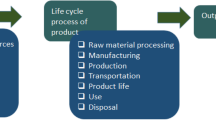Abstract
Purpose
Due to increasing environmental concerns about petroleum-based products, the replacement of petro-products has attracted much attention in recent years. The purpose of this paper was to evaluate the potential environmental impacts of glycerol-based structural bio-adhesive produced through the reversible addition-fragmentation chain transfer polymerization process.
Methods
In this study, two pathways of glycerol production were considered in this cradle-to-gate life cycle assessment: bio-glycerol produced from biodiesel production plant and petroleum-based glycerol derived from petroleum refineries. Several impact categories were analyzed including global warming potential, acidification potential, eutrophication potential, and human health effects (both cancer and non-cancer). The impact of different allocation methods (energy content, mass value, and economic value) was also explored in this study.
Results
Our results showed that bio-glycerol-based structural adhesive had a lower environmental impact in general compared to petro-glycerol-based structural adhesive. Higher environmental impacts throughout the structural bio-adhesive life cycle were observed by adopting the energy allocation method. The key factors that influence the global warming potential were electricity sources and the product yield.
Conclusions
This LCA study provides useful information for developing sustainable biomaterials and processes. It is recommended to further explore the potential approaches to reduce the carbon intensity and eutrophication potential in the RAFT polymerization process as it is identified as the hotspot in the structural bio-adhesive production process.








Similar content being viewed by others
References
Behr A, Eilting J, Irawadi K, Leschinski J, Lindner F (2008) Improved utilisation of renewable resources: new important derivatives of glycerol. Green Chem 10(1):13–30. https://doi.org/10.1039/b710561d
Cespi, D, F. Passarini, G. Mastragostino, I. Vassura, S. Larocca, A. Iaconi, A. Chieregato, J.-L. Dubois, and F. Cavani. 2015. “Glycerol as feedstock in the synthesis of chemicals: a life cycle analysis for acrolein production.” Green Chem 17: 343–355. https://doi.org/10.1039/C4GC01497A
Chakraborty S, Jähnichen K, Komber H, Basfar AA, Voit B (2014) Synthesis of magnetic polystyrene nanoparticles using amphiphilic ionic liquid stabilized RAFT mediated miniemulsion polymerization. Macromolecules 47(13):4186–4198. https://doi.org/10.1021/ma5008013
DOE, US. 2019. “Alternative fuel data center.” 2019
Dreyer LC, Niemann AL, Hauschild MZ (2003) Comparison of three different LCIA methods: EDIP97, CML2001 and Eco-Indicator 99: does it matter which one you choose? Int J Life Cycle Assess 8(4):191–200. https://doi.org/10.1007/BF02978471
Frihart, Charles. 2006. “Biobased adhesives and non-convential bonding.” Sustainable Development In The Forest Product Industry, 88–110
Guinée, Jeroen B., M. Gorrée, Reinout Heijungs, Gjalt Huppes, R. Kleijn, A. Wegener Sleeswijk, Helias a. Udo De Haes, J.a. de Bruijn, R. van Duin, and Mark a.J. Huijbregts. 2001. “Life cycle assessment: an operational guide to the ISO standards.” III: Scientific Background, 692. https://doi.org/10.1300/J082v38n04_05
Guinée JB, Heijungs R, Huppes G, Zamagni A, Masoni P, Buonamici R, Ekvall T, Rydberg T (2011) Life cycle assessment: past, present, and future. Environmental Science & Technology 45(1):90–96. https://doi.org/10.1021/es101316v
Hernández N, Christopher Williams R, Cochran EW (2014) The battle for the ‘green’ polymer. different approaches for biopolymer synthesis: bioadvantaged vs. bioreplacement. Org Biomol Chem 12(18):2834–2849. https://doi.org/10.1039/c3ob42339e
Humbird, David, R. Davis, L. Tao, C. Kinchin, D Hsu, and A Aden. 2011. “Process design and economics for biochemical conversion of lignocellulosic biomass to ethanol.” Golden
Iowa State University. 2008. “Liquid fuel measurements and conversions”
ISO. 2006. “Environmental management - life cycle assessment - principles and framework (ISO 14040:2006).” International Organization for Standardization. https://doi.org/10.1016/j.ecolind.2011.01.007
Landress L (2014) ICIS pricing, glycerine (US gulf). ICIS. 2014 https://www.icis.com/globalassets/global/icis/pdfs/sample-reports/chemicals-glycerine.pdf
Lichtenthaler FW (2010) Carbohydrates as organic raw materials. Wiley-VCH Verlag GmbH & Co., Weinhein
Liu, Yuan, and Kaichang Li. 2002. “Chemical modification of soy protein for wood adhesives,” 739–42
Lowe AB, McCormick CL (2007) Reversible addition-fragmentation chain transfer (RAFT) radical polymerization and the synthesis of water-soluble (co)polymers under homogeneous conditions in organic and aqueous media. Progress in Polymer Science (Oxford) 32(3):283–351. https://doi.org/10.1016/j.progpolymsci.2006.11.003
MarketsandMarkets. 2019. “Adhesives & sealants market worth $73.8 billion by 2024.” 2019
McDevitt JE, Grigsby WJ (2014) Life cycle assessment of bio- and petro-chemical adhesives used in fiberboard production. J Polym Environ 22(4):537–544. https://doi.org/10.1007/s10924-014-0677-4
Nossin, PMM. 2009. “White technology: replacing black gold?” In Fifth Internation Conference on Renewable Resources and Biorefineries
Ortiz O, Castells F, Sonnemann G (2009) Sustainability in the construction industry: a review of recent developments based on LCA. Constr Build Mater 23(1):28–39. https://doi.org/10.1016/j.conbuildmat.2007.11.012
Pizzi A (2006) Recent developments in eco-efficient bio-based adhesives for wood bonding: opportunities and issues. J Adhes Sci Technol 20(8):829–846. https://doi.org/10.1163/156856106777638635
Semsarilar M, Perrier S (2010) ‘Green’ reversible addition-fragmentation chain-transfer (RAFT) polymerization. Nat Chem 2(10):811–820. https://doi.org/10.1038/nchem.853
Sheehan, John, Vince Camobreco, James Duffield, Michael Graboski, and Housein Shapouri. 1998. “Life cycle inventory of biodiesel and petroleum diesel for use in an urban bus”
EIA US (2019) Monthly biodiesel production report. Washington, DC
U.S. Energy Information Administration. 2017. “Electric power monthly”
University of Strathclyde. 2017. “Calorific values.” 2017
Yang, Minliang, and Kurt A Rosentrater. 2019. “Techno-economic analysis of the production process of structural bio-adhesive derived from glycerol.” J Clean Prod 228: 388–398. https://doi.org/10.1016/j.jclepro.2019.04.288
Zhang B, Wang X, Zhu A, Ma K, Lv Y, Wang X, An Z (2015) Enzyme-initiated reversible addition-fragmentation chain transfer polymerization. Macromolecules 48(21):7792–7802. https://doi.org/10.1021/acs.macromol.5b01893
Funding
This study was funded by the National Institute of Food and Agriculture of the United States Department of Agricultural, under project number 214-38202-22318.
Author information
Authors and Affiliations
Corresponding author
Ethics declarations
Conflict of interest
The authors declare that they have no conflicts of interest.
Additional information
Commucated by Carlo Ingrao
Publisher’s note
Springer Nature remains neutral with regard to jurisdictional claims in published maps and institutional affiliations.
Rights and permissions
About this article
Cite this article
Yang, M., Rosentrater, K.A. Cradle-to-gate life cycle assessment of structural bio-adhesives derived from glycerol. Int J Life Cycle Assess 26, 799–806 (2021). https://doi.org/10.1007/s11367-020-01733-9
Received:
Accepted:
Published:
Issue Date:
DOI: https://doi.org/10.1007/s11367-020-01733-9




